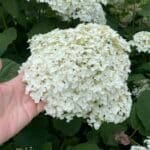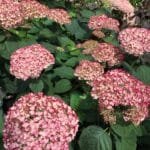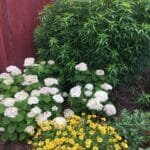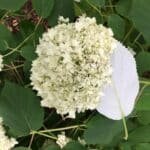I’ve said it before, but I’ll say it again just to keep me out of hot water – I love grandmas. Really. I love the whole concept of grandmas. My darling wife is even getting ready to be a grandma very shortly!
But when it comes to hydrangeas, the options out there on the market these days are nothing like what my grandmas grew in their gardens. It’s a brave new hydrangea world out there and there’s simply no excuse for growing one that just doesn’t measure up in the garden.
Hydrangeas – It’s quite a diverse group of plants. From shrubs to climbing vines and even a few smallish trees, there are about 75 species worldwide, primarily in Asia and North/Central America. There are a few species that most people know, and then there’s species like Hydrangea seemanii, a stunning, glossy evergreen climber that, alas, doesn’t have a prayer here in Kentucky. Trust me. I’ve tried . . . and tried!
Unfortunately for those of us who garden in middle America, often the hydrangea you see in nurseries and garden centers is one of the least well adapted to our climate.
The bigleaf hydrangea (H. macrophylla) is the ubiquitous, 4’ mound of usually green foliage with occasional summer blooms of stunning pink to purpleish blue. But here’s the problem. As a primarily maritime species (it’s native to much of Japan) it evolved where seasonal weather conditions are moderated by the oceans. In coastal areas, the large thermal mass of the oceans limits those wild temperature swings we see in more continental areas.
Growing in a wildly fluctuating climate zone, your bigleaf hydrangea reads those two 70-degree February days as spring – their buds start swelling and maybe even unfolding, and eventually dying when freezing weather returns. And since the fall-set flowers are inside those swelling buds, the freezing temperatures are curtains for the coming season’s blooms.
Add to the flower damage woes the fact that those maritime species have also evolved to thrive in climates with nice, even rain distribution throughout the year. I think the last time we had a nice, even and plentiful summer rain supply in Kentucky was the summer Huck Finn got stuck painting his fence!
Bigleaf hydrangeas in Kentucky, and quite frankly the rest of the middle part of North America, are water hogs. If they don’t get supplemental irrigation through the summer, they look much like wilted lettuce on a stick. Not a pretty sight.
But there is hope!
There’s a hydrangea that is actually native to Kentucky and much of the eastern US. The smooth hydrangea (H. arborescens) forms about a 4-foot-tall, mounded shrub in understory settings throughout its range. Rather than pink or blue, its flowers are gleaming white on most varieties. And since it evolved in interior North America, it’s never fooled by those midwinter warm-ups. It even produces flower buds both in the fall (called old wood flower bud set) as well as spring (new wood flowering) just to be safe.
For decades, the penultimate smooth hydrangea was the cultivar named ‘Annabelle’, discovered in the early 1900s and formally introduced by the University of Illinois horticulture professor, Dr. Joe McDaniel in 1960. For years there were a few other forms out there but ‘Annabelle’ was pretty much the full story of the species. That all started to change about 15 or so years ago.
Now you can find a wide range of smooth hydrangea cultivars out there. With a little looking there are tall and short forms. There are whites, pale pinks, dark rubys, dwarf greenish/whitish offerings. There are even some out there with double flowers. Most have a mix of showy sterile flowers and not-so-showy fertile flowers that the insects love. Here’s a list of a few of our favorites:

Incrediball® (‘Abetwo’)
This is essentially ‘Annabelle’ on steroids. Big, saucer-sized white bloom heads are set on strong stems that resist flopping, even under the weight of the impressive flower set. Will grow to a good five feet or more in height.

Invencibelle® Ruby
Probably our favorite of the newer pinks, this one tops out at about four feet tall with deep, vibrant, pink/red flowers. It’s color holds up well in the summer heat. Bloom heads are not as large as Incrediball, but heck . . . it’s screaming pink!

Invencibelle Wee White® (‘NCHA5’)
On the opposite side of the size spectrum from Incrediball, this one will mature to about 2.5 feet tall with dense, creamy white floral displays.

‘Haas Halo’
If you want pollinators on your hydrangeas, this is a no-brainer. Selected for huge masses of flat-topped blooms consisting mostly of the not-so-showy, fertile flowers with a delicate ring of showier sterile flowers around the edge of each floral mass. Bloom heads can get to be 12” or even 14” inches across and are held erect by good, sturdy stems.

‘Terry Greer’
A bit of a horticultural oddity, this one is a selection of the botanical variety Hydrangea arborescens var. radiata. It is essentially a small-growing variety with silver-backed leaves found primarily in higher Appalachian elevations. It is less heat and drought tolerant compared to the straight species. The cultivar ‘Terry Greer’ has small masses of highly doubled flowers in a creamy white. They produce no nectar or seed as all the individual flowers are sterile. So, while most Hydrangea arborescens plants and cultivars are known as pollinator magnets, ‘Terry Greer’ is usually devoid of pollinators when in bloom.

This article was originally submitted to the Courier Journal on June 20, 2023.

